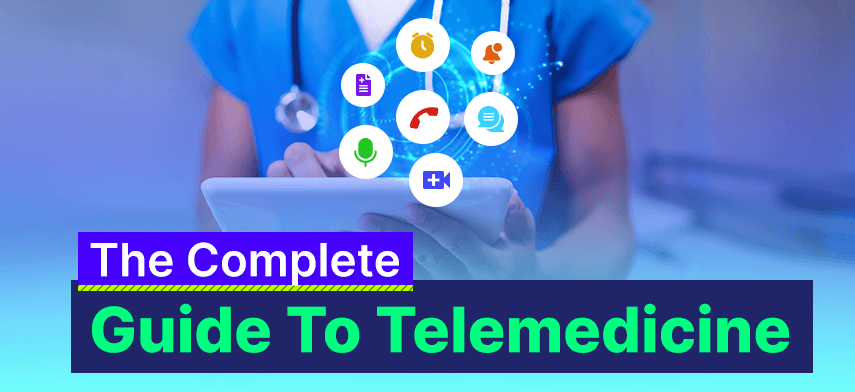With so much variation in the healthcare delivery system, most of the providers are now altering their business models to meet patients’ needs. Rapidly evolving digital healthcare technologies are driving phenomenal growth to healthcare providers, enhancing digital proximity to enable quality care anytime, anywhere in the world. Among all digital healthcare solutions, a HIPAA compliant telemedicine platform is making the most remarkable impact on the healthcare sector with its advanced patient-centric and value-based care solutions.

This guide will help you to understand in and out of the telemedicine solution. It has been designed to meet the unmet healthcare needs of the masses.
Telemedicine At A Glance
- What is Telemedicine?
- Origin and History of Telemedicine
- Today’s Telemedicine – Current State
- Telemedicine vs. Telehealth
- Advantages of Telemedicine
- Challenges of Telemedicine
- Services Provided by Telemedicine
- Telemedicine Delivery Mechanisms
- Applications of Telemedicine
- Telemedicine Legal and Regulatory Aspects
- Conclusion
What Is Telemedicine?
Simply defining the term, telemedicine means healing at a distance with the use of technology to improve patient outcomes. Telemedicine uses digital tools and telecommunication technology to solve medical problems at a distance, as well as enables the opportunity to explore innovative healthcare technologies to improve the quality of care.
According to the American Telemedicine Association,
“Telemedicine is the use of medical information exchanged from one site to another via electronic communications to improve a patient’s clinical health status. Telemedicine includes a growing variety of applications and services using two-way video, email, smartphones, wireless tools, and other forms of telecommunications technology.”
According to WHO,
“The delivery of health care services, where distance is a critical factor, by all health care professionals using information and communication technologies for the exchange of valid information for the diagnosis, treatment, and prevention of disease and injuries, research and evaluation, and for the continuing education of health care providers, all in the interests of advancing the health of individuals and their communities.”
Key elements of telemedicine are,
- Intending to enhance patient outcomes
- Presenting quality and value-based healthcare services
- Utilizing Information and Communication Technology
- Exploring various digital technologies
- Overcoming geographic barriers
Origin And History Of Telemedicine

Roots of telemedicine lie in the evolution of telecommunication technologies in ancient times when humans used to communicate at a distance through visible signals or sound patterns i.e. using fire or drum to send a message. Unless and until, a series of electronic communication technologies invented in the 18th century. The United States of America implemented the first intercity telegraph service between Washington and Baltimore in 1844. Later on, the military also used telegraph service to order medical supplies and other lists during the world war. So, that was just the origin of using the telegraph in the early decades for medical services.
In 1876, Alexander Graham Bell patented the invention of the telephone, a device used for electronic communication transmission. As he continued investigating further, telecommunication was upgraded with long-distance telephone links, multiple telephone lines, circuits, and automatic switching systems. Sharing images and audio signals became possible later on due to technological innovations, including radio transmissions in 1887 by Henry Rudolf Hertz. Major city hospitals installed telephones, and doctors could talk to their patients to give medical advice from a distance. Even talking with other physicians became possible with this innovation.
Development of Telemedicine
The 19th century was a decade of innovations. Transmitting instrumental readings as stethoscope over telephone or radio began in the first half of 1900. Dr. Hugo Gernsback, the pioneer of radio and publishing, predicted the future of radio communication as well as a device in 1924, which would enable doctors to consult their patients through a video screen and touch them with robotic arms at a distance. That was his prediction of telemedicine. Later on, many hospitals, as well as NASA, the military used telemedicine.
The University of Nebraska used video telemedicine consultation for the first time in 1959 to transmit neurological examinations, followed by other programs such as x-rays, ECGs. Later on, NASA also used telemedicine for its astronauts to provide healthcare in space in 1960. Various telemedicine applications were developed afterward to provide virtual care for rural areas.
The rise of the internet has changed the face of telemedicine after the 1990s. Considering the potential for telemedicine, the US government also funded projects related to telemedicine. Various telemedicine policies, systems, software, and applications were developed to provide care at a distance.
Today’s Telemedicine – Current State
Today’s fast-changing technology has upgraded telemedicine more than ever before. Telemedicine has become advanced and easy to use through various technology-led tools such as smartphone apps, cameras, video conferencing, and wearable devices. Video connections have become high resolution, faster, and more reliable to interact on smartphones now.
Telemedicine software for providers is helping to bridge the gap between patients and physicians to enable quality care. Most of the healthcare organizations use telemedicine software for diagnosis and to streamline clinical workflow. The adoption of telemedicine has increased over the last five years. Because today’s patients want immediate care and do not want to waste time in the waiting room.
The innovative concept of virtual care delivery has many aspects, such as remote monitoring, e-prescription, virtual appointments, and consultations. It has improved the quality of providing medical care with a range of applications and healthcare tools. Exchanging medical information has become possible in various formats like text, image, video, document, or pdf. Today’s telemedicine meets the requirements of healthcare consumers as well as professionals by overcoming geographic barriers. It is totally different from the traditional tools for providing care.
Telemedicine software for hospitals focuses on preventive care and offers new means to communicate with healthcare consumers. By increasing the convenience to access healthcare services when needed, it reduces the potential travel time and readmissions time of patients. On the other side, it also improves the care delivery process for practitioners by allowing them to engage with patients through audio or video call, thereby enhancing follow up care and improving patient outcomes. Furthermore, today’s white label telemedicine platform addresses all security and HIPAA concerns to protect health information online.
Telemedicine has several approaches to provide medical treatment. Refer to this blog to understand the same.
Telemedicine vs. Telehealth
Often both the terms are used interchangeably; the concept of the two terms is different. No doubt, they are similar in many aspects, but each concept has its own way of providing healthcare services. So is it telemedicine or telehealth? Telehealth covers the clinical and non-clinical healthcare services at a distance, while telemedicine covers remote clinical services only.
Telemedicine is focused on providing only education and medical care, diagnosis, and treatment-related services at a distance. It is treatment-centric and limited to the delivery of care only. It uses telecommunication technology to provide medical care. Conducting diagnostic tests, monitoring patients’ progress after treatment, video consultations with specialists are examples of telemedicine.
On the other hand, telehealth includes a wider variety of healthcare services at a distance beyond providing only medical care. It consists of all healthcare stakeholders like physicians, care teams, nurses, specialists, or pharmacists. It uses multiple telecommunication technologies to support healthcare management, literature, and access to medical knowledge. Health education, ECG, virtual medical consultations, patient monitoring, managing clinical workflows, providing training, and conducting administrative meetings are examples of telehealth.
Advantages Of Telemedicine
Telemedicine is the best fit for healthcare stakeholders when it comes to providing quality virtual care. One can use it to get medical and health-related information. One can get medical treatment from a distance, where medical facilities are not available nearby. There are several advantages of using telemedicine for healthcare organizations; the main fundamental benefits are described here as under:
1 Increased Flexibility
Telemedicine offers more flexibility to healthcare providers for monitoring their patients and improving patient outcomes compared to the traditional way of care. It is available in different forms, like a mobile app, software, or cloud-based solutions. Multiple technologies can be leveraged in solutions to enhance patient care. It helps to streamline clinical workflows, thereby providing the flexibility to medical staff to manage work-life balance. Even patients can schedule their appointments as per their convenience, and that best suits the needs of the physicians.
2 Cost-Effective
Telemedicine helps healthcare professionals to reduce their healthcare costs by managing chronic diseases virtually, managing medical staffing, reducing travel time, and lessening hospital stays. The virtual care delivery concept enables providers to engage with patients through virtual meetings. They can store the medical data of their patients on a single platform like medical history, lab reports, appointment or consultation history, prescriptions, and billings of each transaction. It reduces the time of offline administration tasks.
3 Improved Quality of Care
Telemedicine enables quick consultation to healthcare consumers. Even providers can also increase engagement with their patients, do frequent follow-up visits, and improve retention ratio of existing patients. Direct medical supervision has become more accessible through telemedicine. It reduces the hospital readmission rate while maintaining patient relationships virtually. It ensures a better quality of care to patients suffering from any diseases and enhances patient outcomes.
4 Most Comprehensive Solution
Telemedicine solutions are advancing at a faster rate with technological advancements and better security controls. Incorporating multiple other healthcare tools and technologies has become possible with telemedicine solutions such as Electronic Health Record (EHR), billing and payment integration, Artificial Intelligence – based diagnosis tools, wearable technology, devices, and sensors. Healthcare providers can provide quality care with cost-effective, customizable, and comprehensive solutions of telemedicine by integrating various technologies in a single platform.
For other benefits, visit the Benefits of Telemedicine blog.
Challenges Of Telemedicine
Despite many benefits of telemedicine, it has a few concerns also, which can be overcome by a proper implementation plan. There are multiple challenges that healthcare organizations face, as mentioned hereunder:
Technical Training
Not every member of your team is tech-savvy or technically sound. The solution requires some training for the team of telemedicine devices or delivery mechanisms.
Lesser Engagement
Technology breakdown or lack of infrastructure can lead to missed instructions or appointments or interaction with patients, thereby reducing the continuity of care.
Lesser In-Person Interaction
Physicians will not be able to perform physical examinations, which are often necessary for diagnosis. Online interaction reduces the in-person visits.
Diagnosis Issue
In some critical cases, physicians may not address the medical condition by interacting online or sharing images or videos appropriately. It may delay the treatment.
Reimbursement
Getting reimbursed is problematic for a few physicians due to telemedicine coverage, state legislation, or policies of private insurance companies.
Security Concerns
Security and privacy of patients’ medical records, as well as other healthcare data, are one of the primary concerns in telemedicine.
Sustainability
Many healthcare organizations may not be able to maintain their telemedicine services after implementation due to reimbursement issues, lack of technical knowledge, or infrastructure.
Services Provided By Telemedicine
Telemedicine enables the systematic provision of healthcare services through telecommunication technology from a distance. It has revolutionized the model of healthcare services. Physicians can diagnose, monitor, and treat certain types of conditions. Here’s the information on telemedicine services:
1 Primary Care
Through the telemedicine approach, providing primary care and specialist referring services from a distance has become possible. Primary care providers can diagnose the patients accurately by video consultation, audio consultation, or transmitting health signs or information.
2 Remote Patient Monitoring
Telemedicine enables the specialist to monitor the health condition of patients post-surgery from a distance. They can collect the health data and share it with tasting facilities for further interpretation. Monitoring by mobile applications also enables the specialist to get actionable insights of various health signs like glucose, sleep pattern, blood pressure, or ECG, while reducing the in-person visits of care teams.
3 Medical Education
Telemedicine provides necessary medical information to all healthcare professionals, care teams, caregivers, and patients. Specialists can organize live seminars, webinars, online discussion groups, or live interaction through mobile apps to provide health information.
Telemedicine Delivery Mechanisms
Telemedicine can be accessed through multiple modes, as mentioned hereunder:
Networked Delivery Mechanism
This mechanism connects the hospitals or clinics with other health centers located in rural or suburban areas through high-speed connectivity lines. It connects the multiple sites to enable virtual care at remote locations.
Point to Point Connection
This mechanism enables the healthcare services to small healthcare centers of remote location through high-speed connectivity lines used by central or larger hospitals. Individual practitioners or small clinics can take advantage of this approach or can outsource healthcare services in their regions.
Monitoring Center Links
This mechanism enables remote patient monitoring at their homes. It creates a digital connection through audio call, text, or wireless internet connectivity between patients and healthcare providers. Measuring vital signs of health, transmitting electronically to specialists, or any facility is possible by this approach.
Internet-based Services
This mechanism enables virtual care delivery through internet-based services like worldwide web services. It encourages patients to take care of their own, help healthcare providers to treat patients earlier, provide cost-effective services, enhance follow up care, and improve on-demand access to healthcare services.
Applications Of Telemedicine
Telemedicine is helping to connect healthcare consumers with healthcare providers and specialists at their convenience through a virtual channel of communication. Realizing the potential of telemedicine, the majority of healthcare organizations are leveraging telemedicine to improve their business ROI. Check this blog for telemedicine statistics. Major factors and useful applications are driving the growth of the telemedicine market. Let us understand its applications:
1 Healthcare Education
Telemedicine provides useful health information by using telecommunication technology. It facilitates easy-to-understand information, training modules, and the latest updates related to healthcare services. Online discussion groups, workshops, seminars, conferences in a virtual environment helps to gain knowledge.
2 Healthcare Delivery
Telemedicine caters to the healthcare needs of consumers using virtual channels. Diagnosing, managing, monitoring, and treating chronic conditions is possible through telemedicine. Physicians, care teams, or any specialists can deliver care services to patients as and when needed. The virtual care delivery concept also provides virtual prescription and billing services to patients without in-person visits.
3 Healthcare Management
Telemedicine provides preventive healthcare through teleconsultation and tele-follow up. It helps healthcare providers to monitor patients’ health signs, follow up care post-surgery, streamline their workflows, manage administrative tasks, and help medical staff to maintain a work-life balance. Care teams can diagnose the patients virtually through telemedicine categories like teleradiology, tele-endoscopy, and manage chronic conditions.
4 Disaster Management
Telemedicine is easily accessible in case of any emergency or crisis. A telemedicine solution is an ideal solution to connect with patients or providers through a smartphone or web-based services during any emergency.
Implementing telemedicine is easier than ever before, learn how to implement telemedicine in your organization.

Telemedicine Legal And Regulatory Aspects
Implementing telemedicine is encouraged worldwide by the government by strictly adhering to the legal aspects as mentioned below:
License
As telemedicine can overcome the geographical boundaries to provide virtual care, it raises legal and regulatory concerns related to licensing. However, most regions require physicians to be licensed for practice. It becomes difficult for providers to identify and verify their patients’ locations at the time of consultation. Hence, it is essential to get the license to provide services in specified regions. Furthermore, cross-state licensing also allows practitioners to provide telemedicine services in a neighboring state without having a license in that region. But it requires additional documentation before practicing in a nearby area of the country.
Physician-Patient Relationship
As per many regions’ standard policy, the usage of telemedicine is prohibited in case the provider has not examined patients through an in-person visit. Both of them have at least one in-person visit. While some regions require a specific form of communication with patients before providing telemedicine. This regulation is changing in a few countries with a transformation in healthcare.
Medical Malpractice Coverage
Telemedicine offers sophisticated ways of providing remote care. But providing remote care in different regions has different standards of care. Some regions have the same rules as in-person visits, while others have more restrictive standards. Hence, it is essential to review medical malpractice insurance policies to provide telemedicine services carefully.
Tele-Prescribing
When it comes to providing an online prescription, many regions have enacted tele-prescribing regulations, such as in-person physical examination of medications. Therefore, providers need to understand the state legislations of prescribing medications through telemedicine.
Reimbursement Policy
Telemedicine implementation varies region-wise in terms of providing reimbursement for delivering healthcare services. Likewise, private payor coverage for telemedicine also varies greatly. Private payers reimburse the same amount as in-person medical services in many regions. Reviewing state rules and regulations before billing is of utmost importance for any provider.
Privacy and Confidentiality (HIPAA)
HIPAA privacy and security rules apply to most healthcare entities, as the act sets the standard for securing patients’ health information, stored or transferred by electronic channels. As per the law, providers must strictly adhere to the main three compliances – administrative, physical, and technical. Hence, the provider should ensure to sign a business agreement with the telemedicine vendor that he is providing a fully encrypted telemedicine solution that protects the privacy of patients’ data.
Conclusion
Telemedicine is one of the valuable platforms that makes remote consultation and care possible from a distance. Accessibility, convenience and cost-effective treatment through telemedicine have advanced the healthcare industry. The use of telecommunication and smart technologies for patient monitoring, consultation, diagnosis, and medication has reduced the gap between supply and demand for healthcare services. Although it includes economic, legal, ethical, and technical issues to survive in the market, telemedicine is a lucrative concept for all healthcare organizations.

Author's Bio

Nitin Lahoti is the Co-Founder and Director at Mobisoft Infotech. He has 15 years of experience in Design, Business Development and Startups. His expertise is in Product Ideation, UX/UI design, Startup consulting and mentoring. He prefers business readings and loves traveling.


